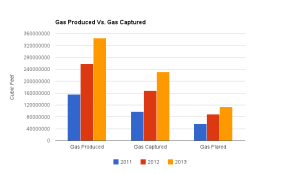North Dakota flaring percentage down since 2011

By Rob Port | Watchdog.org North Dakota Bureau
FLARING PROGRESS: From 2011 to 2013 growth in the amount of gas captured has outpaced growth in the amount of gas flared. Graph created by Watchdog based on DMR gas flaring and capture numbers.
BISMARCK, N.D. — North Dakota’s booming oil production has also produced a boom in a byproduct of oil drilling — natural gas.
But the rapid boost in gas production have led to increases in the amount of excess gas flared off, prompting a debate over the waste of a valuable commodity and the environmental impact of burning it.
However, the most recent gas production and capture numbers from the North Dakota Industrial Commission’s Department of Mineral Resources, show it’s a situation that is improving.
The DMR’s latest report covering activity through December 2013 shows that the amount of gas captured was down in the month due to a gas plant near Tioga going offline for upgrades, but overall in 2013 the amount of gas captured was up 37 percent over 2012 and up more than 135 percent over 2011.
Capture has grown faster than overall production, which increased 122 percent from 2011 to 2013.
The percentage of gas flared has decreased 36.84 percent in 2011 to 33 percent in 2013.
The flaring issue has drawn national scrutiny. In July 2013, Reuters reported that the state was burning off as much as $100 million worth of gas per month. Capture of gas produced in North Dakota’s oil fields has been complicated by low prices.
Still, the oil industry has announced plans to increase the amount of gas captured even further in coming years.
FLARING DOWN: The percentage of natural gas flared in North Dakota has decreased since 2011. Graph created by Watchdog based on DMR gas flaring and capture numbers.
The North Dakota Petroleum Council, an advocacy and lobbying group representing the state’s oil and gas industry, announced in January that “the industry can increase natural gas capture to 85 percent within two years, 90 percent capture in six years, and could capture up to 95 percent of gas.”
The group’s flaring task force has recommended oil and gas producers be required to develop a gas capture plan for new wells drilled, enforced by regulatory consequences from the state, and they’re also calling for policies making it easier to build gas capture pipelines.
“Pipeline infrastructure is crucial in capturing natural gas, and inability to obtain right of ways is a primary cause of natural gas flaring,” the NDPC states in a press release. “Easements may take 180 days or more to obtain, which is the period that a well is producing at its highest rate. In some cases, landowners will not grant easements at all. The industry recommends that a ROW [Right Of Way] Task Force be formed to review potential legislation to improve ROW access to reduce flaring.”
Contact Rob Port at rport@watchdog.org
The post North Dakota flaring percentage down since 2011 appeared first on Watchdog.org.







